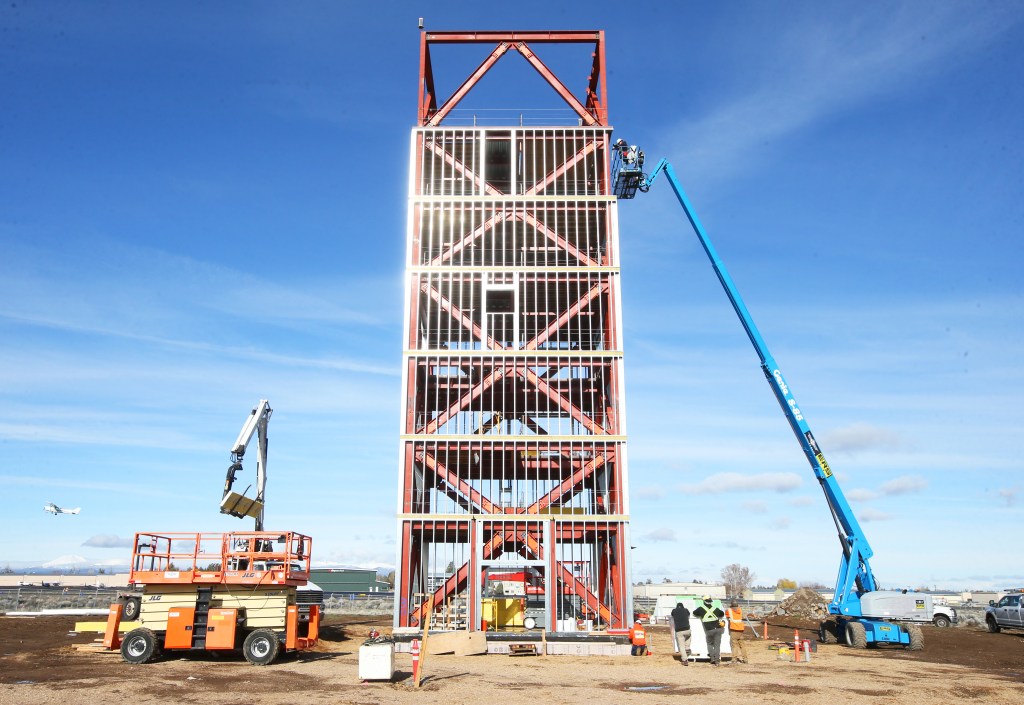Soon to be Bend’s tallest building: Air traffic control tower
Published 1:16 pm Thursday, April 10, 2025

- The new $15 million air traffic control tower at the Bend Municipal Airport being construction under sunny skies in Bend Wednesday morning. 4-2-25
On Wednesday morning when skies were calm and blue, chatter filled the airwaves at the Bend Municipal Airport.
In a language of letters, numbers and directions, the conversation was an off-the-cuff effort of pilots to avoid a conflict as multiple planes were taking off and landing each minute.
There are more takeoffs and landings at this small airport east of Bend than all but two others in the state. Twice as many aircraft go in and out each year than at the Redmond Airport.
Still, there is no one to direct them.
Behind the wheel of a small Ford SUV, Airport Manager Tracy Williams chimed in to the conversation, announcing an “expedited” crossing of the runway. The car sped across safely.
By next year, this runway dance will be much different. The airport is about one-third finished with construction of a new $10 million air traffic control tower, where controllers will orchestrate takeoffs and landings from an eight-story perch.
At the construction site just east of the runway, crews have built the tower’s seven-story steel frame. Its base is 25 feet by 25 feet. Crews still need to add an eighth story, an octagonal cab where controllers will work.
The tower will stand 115 feet high, taller than any building in Bend.
The tower will also feature a rotating beacon, antennas, lightning rods, a service road, a parking area, utility connections, a perimeter fence and weather sensors on a mast.
The tower was initially expected to be complete in October, but delays have pushed the completion back to January 2026.
Williams, who pushed for several years to secure federal funding for the tower, has watched from her office window across the runway as the steel structure goes up. She’s especially excited about the tower’s modern design, including the outdoor deck facing the runway where controllers can sit on breaks.
“We’re building a brand new tower, might as well make it cool,” she said.
According to Williams, it will be the first federally funded air traffic control tower to open in the last five years that’s not owned and operated by the Federal Aviation Administration.
The tower will add a layer of safety to the airport, but it doesn’t mean larger aircraft will begin flocking there, Williams said.
Corporate, medical and private planes all use the Bend airport. About 300 planes are housed there. About one-third of the air traffic can be attributed to training and flight schools, including small helicopters.
Some pilots fly planes using instruments to navigate, others by sight. They could be approaching the airport at 60 miles per hour or 160, on trips that could range from a few miles to hundreds.
“That combination of traffic can create lots of conflicts,” said Brian Shelk, a commercial-rated pilot who has been flying for fun out of the Bend airport for more than a decade. Shelk was rolling his blue Cessna 185 from a hangar Wednesday morning as he prepared to fly over Burns to examine recent severe flooding. “There’s no one organizing the takeoffs and landings. It’s all up to the pilots to talk on the radio and coordinate amongst themselves.”
For pilots, using a towerless airport comes at a cost. A disorganized runway queue means planes sometimes idle for minutes, guzzling gallons of gas. If a larger plane approaches the airport too quickly with a smaller, slower plane in front of it, the larger plane might have to pull up and circle back around, which can cost thousands of dollars.
Nationally, recent incidents of mid-air collisions and near-misses have created a heightened sense of awareness about the dangers of flying.
“So much of that could be mitigated with an air traffic control tower organizing aircraft, sequencing them based on their speed,” Shelk said.







